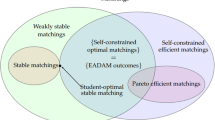Abstract
A case study of matching students with dormitory-groups at the Technion lead recently to the study of a variant of the stable matching model with a “qualifying criterion” for the inclusion of a student among those getting an assignment. A notion of stability was introduced for the model and a (student-courting) algorithm which finds a matching that satisfied this criterion and has desired properties was described. Here, we show that students cannot benefit from misrepresenting preferences in an extension of the model that allows dormitory-groups to have different preferences over students and allows these preferences to be incomplete.
Similar content being viewed by others
References
Abdulkadiroglu A, Pathak PA, Roth AE (2005a) The New York City High School match. Am Econ Rev 95: 364–367
Abdulkadiroglu A, Pathak PA, Roth AE (2005b) The Boston Public School match. Am Econ Rev 95: 368–371
Abdulkadiroğlu A, Sonmez T (2003) School choice: a mechanism design approach. Am Econ Rev 93: 729–747
Dubins LE, Friedman DA (1981) Machiavellian and the Gale–Shapley algorithm. Am Math Month 88: 485–494
Gale D, Shapley L (1962) Collage admissions and the stability of marriage. Am Math Month 69: 9–15
Gale D, Sotomayor M (1985a) Some remarks on the stable matching problem. Discr Appl Math 11: 223–232
Gale D, Sotomayor M (1985b) Ms Machiavelli and the stable matching problem. Am Math Month 92: 261–268
Gustfield D, Irving RW (1989) The stable marriage problem: structure and algorithms. The MIT Press, Cambridge
Knuth DE (1976) Marriages stables. Les Presses de l’Universite Montreal, Montreal
McVitie DG, Wilson LB (1970) Stable marriage assignment for unequal sets. BIT 10: 295–309
Perach N, Polak J, Rothblum UG (2007) A stable matching model with an entrance criterion applied to the assignment of students to dormitories at the Technion. Int J Game Theory 10: 519–535
Roth AE (1984) The evolution of the labor market for medical interns and residents: a case study in game theory. J Polit Econ 92: 991–1016
Roth AE (2002) The economist as engineer: game theory, experimentation, and computation as tools for design economics. Econometrica 70: 1341–1378
Roth AE (2008) Deferred acceptance algorithms: history, theory, practice, and open questions. Int J Game Theory 36: 537–569
Roth AE, Sotomayor MOA (1990) Two-sided matching: a study in game-theoretic modeling and analysis, Econometric Society Monographs Series, Cambridge University
Roth AE, Sonmez T, Unver MU (2007) Efficient kidney exchange: coincidence of wants in markets with compatibility-based preferences. Am Econ Rev 97: 828–851
Author information
Authors and Affiliations
Corresponding author
Rights and permissions
About this article
Cite this article
Perach, N., Rothblum, U.G. Incentive compatibility for the stable matching model with an entrance criterion. Int J Game Theory 39, 657–667 (2010). https://doi.org/10.1007/s00182-009-0210-5
Accepted:
Published:
Issue Date:
DOI: https://doi.org/10.1007/s00182-009-0210-5




